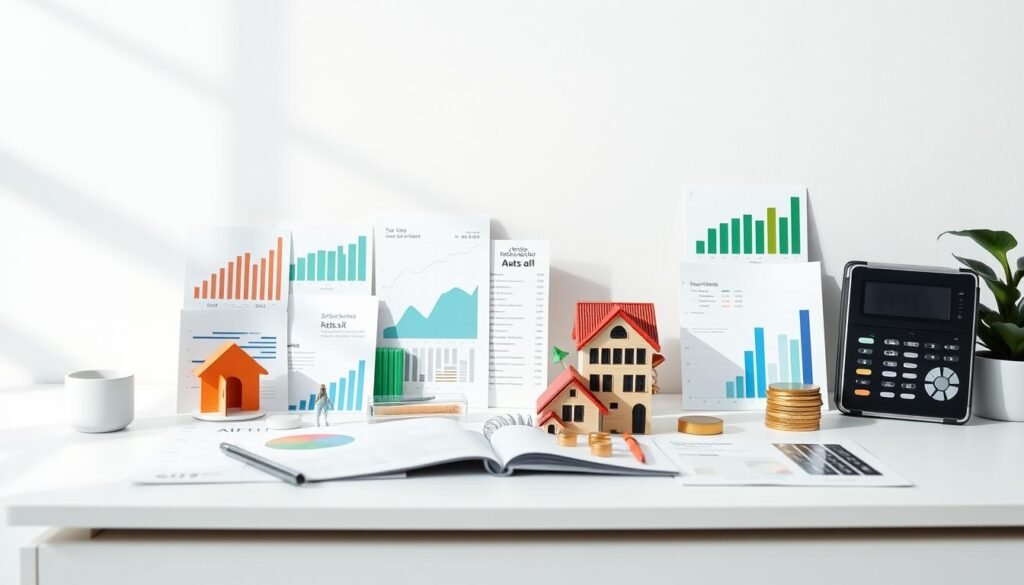I remember the sinking feeling in 2020 when the market seemed to vanish overnight. Many people felt the same panic watching charts and headlines, worrying about retirement buying power as prices climbed.
What can I put in my IRA that won’t just disappear if prices keep rising? This guide answers that question with clear options and a calm tone. No single holding is flawless, but a resilient mix of equities, bonds, real assets, and cash buffers helps protect long-term retirement savings.
History shows quick recoveries after sharp drops. The stock market’s rebound after March 2020 reminds us that staying invested and diversifying a portfolio matters more than timing every move.
Read on for practical steps: account type, tax approach, asset mix, low-cost funds, and habits like automatic contributions and regular rebalancing that keep money working through cycles.
Key Takeaways
- Diversify across stocks, bonds, real assets, and cash to manage risk.
- History favors patient investors who stay invested through market turbulence.
- Automate contributions and rebalance to keep a durable portfolio.
- Choose low-cost funds and tax-smart accounts to boost retirement savings.
- Tailor your strategy to your timeline and comfort with risk.
Understand inflation risk and market volatility before you invest
Inflation quietly shrinks your buying power unless returns keep pace. In plain terms, when general prices rise faster than your portfolio returns, your retirement income buys less over time.
How inflation erodes purchasing power in retirement
Plan for returns that outpace inflation. If earnings lag, future retirement cash will cover fewer essentials. Different sectors of the economy and shifts in demand push prices up or down, so build expectations around ongoing inflation when you set allocation.
Volatility vs. crashes: why staying invested matters
Market corrections of 10% or more crop up every few years, while true crashes are rarer but deeper. The 2020 downturn and rapid rebound is a clear example—investors who exited then locked in losses and missed later gains.
- Returns are lumpy: some years beat expectations, some fall short.
- Diversifying across stocks, bonds, and cash reduces single-event risk.
- Time in the market usually beats timing the stock market.
Next, learn how to match account type and allocation to these realities so choices feel intentional rather than reactive.
Clarify your IRA type and tax strategy for resilient returns
Choose an account type that matches your tax outlook and long-term goals.
Traditional vs. Roth at a glance: A Traditional account often gives a current tax deduction and taxes withdrawals in retirement. A Roth uses after-tax dollars so growth and qualified withdrawals are tax-free.
For 2024, Roth contribution limits are $7,000, plus a $1,000 catch-up if you are 50 or older. Eligibility phases out based on MAGI: singles see full access under $146,000 and no direct contributions at $161,000 or more. Married filers phase out between $230,000 and $240,000.
Backdoor Roth basics
The backdoor route uses a non-deductible Traditional contribution followed by a conversion to a Roth. Beware the pro-rata rule: having other pre-tax IRA balances can make part of the conversion taxable.
“Contribute early in the year to capture more compounding time.”
Timing and contribution strategy
Don’t wait until tax day. Early or monthly contributions increase compounding time and reduce timing risk in a volatile market.
| Feature | Traditional | Roth |
|---|---|---|
| Immediate tax benefit | Possible deduction | No |
| Withdrawals in retirement | Taxable | Tax-free if rules met |
| Good if you expect | Lower tax bracket later | Higher tax bracket later |
| High-income option | Available | Use backdoor conversion |
Coordinate contributions with your overall retirement plan and talk with a financial advisor or tax professional to tailor choices to your income and long-term savings goals.
What can I put in my IRA that won’t just disappear if prices keep rising?
A durable retirement plan mixes engines for growth with ballast that soothes volatility.
Diversification and a clear asset allocation set the stage. Broad stocks act as growth engines to outpace inflation over long time frames. Short-duration bonds and cash supply ballast to reduce swings near retirement.
Include inflation hedges such as REITs or commodities and a modest allocation to precious metals. These assets may hold value when overall prices climb, but they also carry unique risks. No single holding is a magic shield.
Keep your allocation aligned with time and risk tolerance. The more time you have, the heavier you can weight growth assets. Nearer-term plans call for more stability and cash reserves.
- Rebalance on a schedule to prevent any asset from dominating.
- Use low-cost, diversified funds to capture broad market exposure without high fees.
- Document a target allocation and stick to it through market cycles.
“Diversify across growth, protection, and inflation hedges for resilient returns.”
Next, we’ll show sample building blocks—equities, bonds, real assets, and cash—and how to blend them into a working strategy.
Build an asset allocation that matches your risk tolerance and time to retirement
Start your allocation by matching stock exposure to how many years remain until retirement.
Rules of thumb offer a quick baseline: try 110 minus your age for stocks. Risk-tolerant investors might use 120 minus age. Conservative savers can use 100 minus age.

Rule-of-thumb ranges vs. customized allocation
Simple formulas are handy, but a customized plan fits income needs, other assets, and true risk tolerance.
Write down your target allocation so the portfolio stays steady when the market gets noisy.
Younger investors, near-retirees, and the glide toward lower risk
Investors with many years can hold more stocks to chase growth. Near-retirees shift gradually toward bonds and cash to reduce sequence risk.
Glide paths slowly dial down stock exposure over time. Target-date funds do this automatically and rebalance for you.
- Rebalance at least annually; consider quarterly if you prefer tighter control.
- Coordinate this IRA allocation with 401(k), HSA, and taxable accounts.
“A thoughtful allocation is the backbone of an inflation-aware retirement strategy.”
Use equities that can hold up when prices rise
Choose equities that mix steady income with long-term growth to help shield buying power as costs climb. High-quality dividend stocks and defensive sectors often fare better when markets get choppy.
Dividend stocks and dividend aristocrats for income and stability
Dividend payers supply income and can smooth volatility. Companies that lift payouts for 25+ years—dividend aristocrats—often have durable business models.
Focus on total returns: dividends plus price appreciation matter more than yield alone. Check balance sheets and debt levels to ensure firms can sustain payouts as costs rise.
Defensive sectors: healthcare, utilities, and consumer staples
People still need medicine, power, and basic goods in every economy. These sectors tend to be less cyclical and can protect a portfolio when the market weakens.
Blend broad market index funds with targeted dividend or sector funds to capture diversification without heavy stock picking.
- Dividend names can support steady income and stability.
- Defensive sectors often hold up better during downturns.
- Use low-cost funds to access these themes efficiently.
“Over the long run, stock returns have outpaced inflation, making equities a core growth engine for retirement savings.”
Add bond strategies designed for changing interest rates
A steady bond sleeve can smooth portfolio swings when rate cycles shift.
Short-duration bonds and bond funds reduce sensitivity to rising interest rates. They cut price volatility and let you reinvest sooner into higher-yielding issues as rates move.
Short-duration bonds and bond funds to manage rate risk
Use high-quality core funds for stability and short-term funds for flexibility. Short-duration funds typically fall less when rates climb and recover faster when new yields rise.
How rising rates affect bond prices and future income
When rates increase, existing bond prices generally fall because new bonds offer higher yields. That creates an opportunity: rolling maturing bonds into fresh issues raises future interest income.
- Build a bond sleeve with core investment-grade funds plus short-term funds to limit volatility while earning steady interest.
- Consider a ladder or short-term ETFs for predictable cash flows near retirement.
- Avoid concentrated credit risk; diversify across issuers and term lengths.
| Objective | Approach | Benefit |
|---|---|---|
| Limit rate risk | Short-duration funds / ladder | Lower price sensitivity to rates |
| Boost future income | Roll into higher-yielding bonds | Higher coupon on new purchases |
| Stable withdrawals | Short-term ETFs or laddered maturities | Predictable cash flow for 1–5 years |
| Cost efficiency | Low-expense bond funds | Preserve net returns |
Remember: inside an IRA, interest compounds tax-deferred (or tax-free in a Roth), which can improve after-tax outcomes compared with taxable accounts.
“Treat bonds as ballast: they won’t outpace stocks long term, but they smooth the journey through changing rate and market regimes.”
Review duration and credit quality periodically and align the bond sleeve with your overall portfolio risk. For more on living from fixed income, check a practical guide to living off interest.
Consider real assets to counter inflation
Tangible investments often move on separate drivers than stocks and bonds, offering useful diversification.
Real estate and REITs for income and inflation linkage
Real estate investment trusts (REITs) can provide steady income through dividends and some linkage to rising prices via rents and property values.
REITs give exposure to commercial, residential, or industrial property without owning a single building. Low-cost REIT ETFs spread that exposure and help manage concentrated-asset risk.
Commodities and precious metals as diversifiers
Commodities and metals diversify traditional investments and sometimes outperform when inflation or stress pushes prices higher.
For example, after March 2023 banking stress and a Fed rate move, gold rose 1.54% and silver jumped 2.79% in a day, showing how demand can shift toward hedges.
- Use broad commodities ETFs and low-cost metal funds to avoid single-asset concentration.
- Keep real asset position sizes aligned with your risk tolerance and overall strategy.
- Trim winners after sharp run-ups and rebalance back to targets to maintain balance in the portfolio.
“Real assets may zig when other parts of the portfolio zag, which is the point of diversification.”
Remember: while these assets may help when prices climb, they are not guaranteed hedges in every market. Document a clear role and range for real assets so they support long-term returns without overwhelming core holdings.
Create a cash and money market buffer to manage sequence risk
Holding short-term savings gives you time and calm when markets wobble near retirement.
Sequence-of-returns risk happens when withdrawals follow a market drop. Taking money out after a decline can permanently harm future income and the long-term sustainability of your nest egg.

Cash reserves for one to five years of living expenses
Many professionals advise keeping three to five years of essential spending in cash or equivalents. A smaller buffer (one to three years) works if you have a pension or steady other income.
Money market funds inside an IRA: when they make sense
Money market funds are useful as a temporary parking spot during allocation changes or when near-term withdrawals loom. They let you earn competitive yields today while you avoid selling stocks at lows.
- Bucket strategy: cash for 1–3 years, bonds for the medium term, stocks for long-term growth.
- Cash cushions help people stick with a written spending plan during drawdowns.
- Trade-off: excess savings reduce long-run return, so size the cash bucket to your comfort and spending needs.
“Treat cash as part of your portfolio and rebalance it into income or growth assets on a set schedule.”
Automate contributions and dollar-cost averaging for steadier results
A simple habit—automatic deposits—turns intentions into progress every pay period.
Set up monthly contributions so your account grows regardless of how the market feels. Automation removes emotion and keeps a steady flow of savings into your plan.
Dollar-cost averaging means investing the same dollar amount on a schedule. Over time, this buys more shares when prices fall and fewer when they rise.
Keep contributions running through downturns. Buying at lower prices can boost long-term outcomes. Likewise, don’t slow deposits in strong markets—consistency helps hit your annual goal.
- Align deposits with paychecks to spread the yearly max across months.
- Use provider tools to schedule transfers and track progress.
- Review contribution levels once a year to match cash flow and taxes.
| Action | Why it helps | How to start |
|---|---|---|
| Auto monthly deposits | Removes timing decisions | Set up with your IRA provider |
| Dollar-cost averaging | Manages price risk | Invest fixed amounts regularly |
| Annual review | Keeps plan aligned with goals | Adjust amounts as needed |
“Automate the routine and focus on the long game; it’s a practical way to make steady progress.”
Rebalance regularly to keep risk in check
Rebalancing is the simple habit that preserves intended exposure across market cycles. It trims outperformers and adds to laggards so your portfolio stays true to its target allocation.

Annual or quarterly checks without tax headaches
Inside an IRA you can rebalance freely without triggering current-year taxes. That is a big advantage when you want to adjust weights after strong moves in the market.
Many investors pick annual reviews; some advisors prefer quarterly. Another option is to set tolerance bands (for example, 5%) so rebalancing happens only when drift matters.
Target-date funds: set it and let the glide path work
Target-date funds embed an automatic shift toward safer assets as your retirement term nears. They handle ongoing rebalancing and keep a clear mix of funds for growth and stability.
For slightly more control, pair a target-date fund with a small sleeve of real assets or short-term bonds. That gives customization while preserving the core strategy.
- Define rebalancing rules and document them to avoid emotional trades.
- Use tolerance bands to limit unnecessary turnover.
- Let an advisor help monitor drift if your mix is complex.
“A disciplined rebalance forces you to buy low and sell high, keeping long-term growth on track.”
Cut costs to protect long-term returns
Small fee differences add up over decades and can reshape retirement outcomes. Keeping fees low is one of the clearest, most reliable moves to boost net savings and improve long-term returns.
Expense ratios, transaction fees, and advisory costs to watch
Check mutual fund and ETF expense ratios first. Even a few basis points lower can leave more money invested each year.
Watch account or transaction fees, and compare any advisor or robo fees to the value you receive. Ask whether planning, tax help, or behavioral coaching justifies the cost.
How a simple cost audit can add years of income
Run a quick audit: list holdings, note each expense ratio, and compare to broad, low-cost alternatives. Consolidate redundant funds and replace expensive options where sensible.
- Key fees: expense ratios, account/transaction fees, advisor/robo fees.
- Avoid frequent trading to reduce transaction costs and keep your plan simple.
- Review costs annually—small savings compound and improve the odds your portfolio outpaces inflation.
| Action | Why it helps | Benefit |
|---|---|---|
| Replace high-cost funds | Lower expense drag | More money compounding |
| Consolidate accounts | Fewer duplicate fees | Simpler monitoring |
| Annual cost review | Capture new low-cost options | Keeps savings growing |
“A 1% fee over decades can shave hundreds of thousands off a balance—so check costs and act.”
Coordinate your plan with taxes, beneficiaries, and professional guidance
The years after you stop working but before required withdrawals start are ideal for tax planning moves.
Roth conversions in this window can be powerful. Converting modest amounts may use lower tax brackets and lock in future tax-free income.
Manage conversions carefully so you do not jump into a higher bracket in any single year. Work with a tax-savvy advisor to model scenarios and choose which assets to convert based on current market levels and long-term growth prospects.
Keep beneficiary designations current. Under recent rules many heirs must empty inherited accounts within 10 years, so a clear beneficiary choice helps simplify estate steps and aligns after-tax results with your goals.
- Plan conversions annually to smooth tax impact.
- Update beneficiaries after major life events.
- Coordinate contribution, asset location, and withdrawal sequencing to improve net retirement outcomes.
“Consider conversions after retirement but before RMDs to take advantage of typically lower taxable income.”
| Decision | Why it matters | When to consult an advisor |
|---|---|---|
| Roth conversion sizing | Controls tax bracket impact | When modeling multi-year taxes |
| Beneficiary updates | Simplifies estate and tax outcomes | After marriages, births, or deaths |
| Asset selection for conversion | Choose loss-packed or high-growth holdings | When market swings change valuations |
When plans are complex, a trusted financial advisor adds value by coordinating accounts, running tax projections, and offering behavioral coaching. Annual check-ins keep the strategy aligned with law changes, income shifts, and market movement so people preserve more retirement income.
Conclusion
Long-term gains come from a clear mix of growth assets, stabilizers, and routine actions, not from timing short-term swings.
Recap the playbook: blend growth-oriented equities with short-term bonds and cash, plus a measured sleeve of real assets to help protect purchasing power. Automate contributions, rebalance on a schedule, and keep fees low to shield retirement savings and improve long-run outcomes.
Align account type and tax moves with your broader plan. Staying invested through the stock market’s ups and downs has helped many investors compound wealth. If you prefer a simple path, consider a target-date fund; otherwise, get a quick cost and allocation audit or talk with a pro to tailor a portfolio to your timeline and risk comfort.
